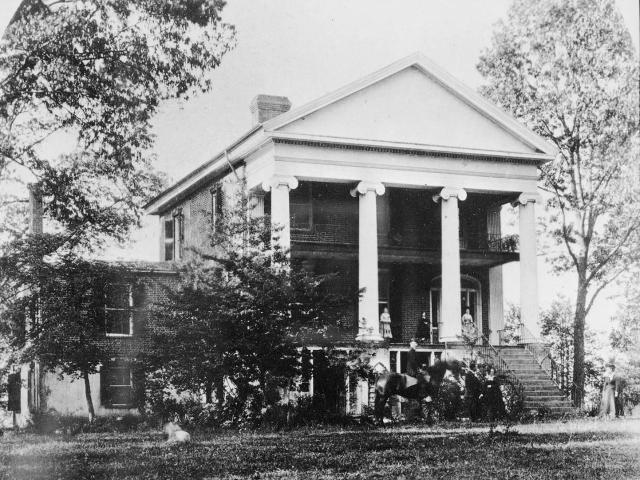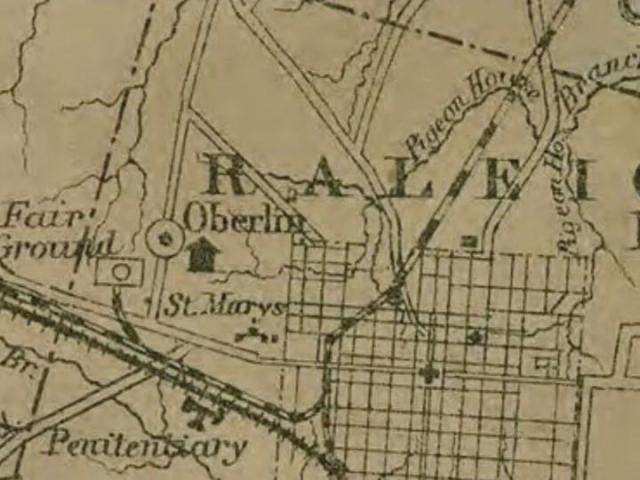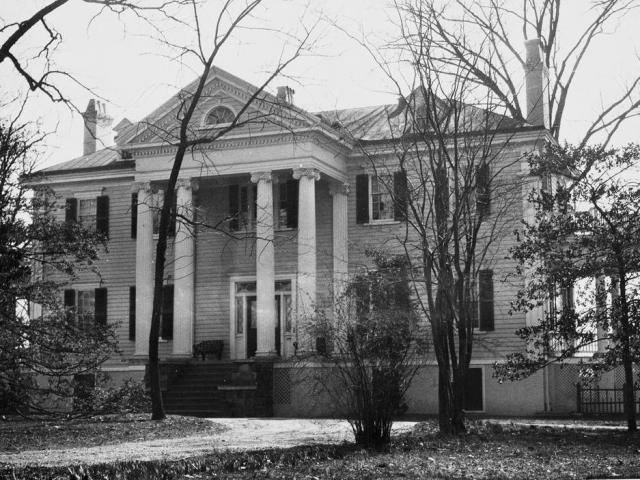Capitol Broadcasting Company’s 2022 DEIB Council has been hard at work creating resources to educate our employees on the significance of Juneteenth, featuring the historic Oberlin Village. WRAL-TV Sports Plus Executive Producer Louis Fernandez and Council Co-Chair MCC Director Business Development Christian Adams assisted with creating a video interview with Grady Bussey, Director of the John Chavis Community Center. WRAL-TV Multiplatform Producer Heather Leah wrote this accompanying piece about the history of Raleigh’s Freedmen’s Villages which the Council also shared on WRAL.com:
First days of freedom: Thousands freed from slavery in Raleigh built the first Freedmen’s Villages
Full of modern day coffee shops, trendy restaurants and boutiques, it may be hard to imagine a time when downtown Raleigh was instead full of sprawling fields, plantation houses – and hundreds of enslaved individuals.
Instead of busy roads and breweries, much of what now comprises downtown was rural – including plantations like Spring Hill, Mordecai, Lane, Devereux, Haywood, Cameron and others.
 Will’s Forest (or Devereux) Mansion, built in 1840
Will’s Forest (or Devereux) Mansion, built in 1840When emancipation finally came to Raleigh, thousands of suddenly freed men and women flooded from those plantations and into the surrounding city. Most had no money, no homes, no formal education. There were no churches, schools or medical facilities to serve the once-enslaved population. How did a generation of freed families build a life for themselves from nothing?
“African-Americans, after slavery, decided to get together and build, brick-by-brick, a community and a sense of ownership that allowed them to thrive,” says Grady Bussey, center director for the John Chavis Memorial Park.
Within a generation of freedom, the African American community in Raleigh had built multiple neighborhoods known as Freedmen’s Villages. There were thriving businesses, government leaders, universities, hospitals and churches.
 What happened to Raleigh’s 13 Freedman Villages?
What happened to Raleigh’s 13 Freedman Villages?Juneteenth in Raleigh: The early days of emancipation
Imagine the first moment of freedom: What is the first thing enslaved men and women in Raleigh did upon learning they were free?
Raleigh historians say some likely walked off the plantation, simply because they could. Many likely celebrated, while others were in shock.
“Think of someone walking up to you and saying everything you’ve known your whole life has just changed,” says Bussey. “You are a full person. You are a descendent now. You have a full name now. You have the ability and rights to do things you didn’t have yesterday.”
Bussey asks, “How do people learn how to become someone new overnight?”
He says some, who likely struggled with the sudden change, stayed on the plantations they’d always known and began working as sharecroppers. Others, who had seen family members sold to plantations far away, began planning long journeys to find their lost loved ones.
Some, however, began the communal work of building their new homes in freedom — establishing Freedmen’s Villages like Oberlin Village and 12 other neighborhoods in the east and south parts of Raleigh. Even today, some of that historic segregation can be seen in the history of southeast Raleigh.
 The Duncan Cameron plantation. Image courtesy of the State Archives of North Carolina.
The Duncan Cameron plantation. Image courtesy of the State Archives of North Carolina.Freedmen’s Villages: Building a community from the ground up
The land that now comprises the Village District (formerly Cameron Village) was once an antebellum plantation owned by Duncan Cameron. Cameron is known to have had one of the largest holdings of enslaved people in the state. His plantation mansion is long gone today, but an archival photo provides a glimpse into how the area once looked.
“Plantations were self-sustaining,” said Bussey. “They had shops and cemeteries, gathering places for church.”
When hundreds of people were suddenly free to leave Cameron’s plantation, they had to figure out how to make money and how to find land for a home.
Oberlin Village was built upon land subdivided from white landowners and sold to newly-freed African Americans, according to research done by Ruth Little for the Historic Research Report for the Designation of Oberlin Village.
“White merchant and entrepreneur Lewis W. Peck is the earliest known landowner to sell lots to African Americans,” she wrote.
The villages were given several derogatory names by the surrounding public: Names like ‘Save-Rent’ or ‘Slab Town’ to invoke a sense of ‘cheapness.’ Eventually, however, the community would take on the name Oberlin Village.
James Harris is often associated with the name Oberlin. One of the leading Black politicians in Wake County, he was born in Granville County while still enslaved. He earned his freedom and traveled to Ohio, where he studied at Oberlin College, then moved around assisting people in escaping slavery. Oberlin College was an abolitionist college that not only accepted Black students, but allowed them to come on campus and matriculate.
For a community of newly-freed slaves, the name Oberlin would have represented the freedom to gain education and build a life of their own – to be uplifted.
“During the 1870s, Oberlin’s pioneers established essential institutions for an independent community – two churches, a cemetery and a school,” wrote Little.
Many of Oberlin Village’s residents throughout the generations became leaders in the community. James Shepard, for example, founded the college that would become North Carolina Central University. Joe Holt was the first Black student to challenge school segregation in Raleigh after Brown vs. the Board of Education.
Just down the road, students themselves built a hospital for the African-American community. Stone-by-stone, these young people quarried rocks from the ground itself and built St. Agnes, a hospital for the African-American community in Raleigh.
Linda Dallas, a professor at St. Augustine’s University, refers to the hospital as “a symbol of making a way out of no way.”
Bussey points out that the idea of building churches, houses and hospitals from the ground up may seem incredible by today’s standards – but, he says, “These people had no other choice. They had to work together and make something from nothing. It’s part of the resiliency of the African-American experience.”
Emancipation Day: An early African-American holiday celebrated in Raleigh
Juneteenth was originally predominately celebrated in Texas; however, Raleigh’s African-American community and many other towns and cities around the south celebrated a holiday called ‘Emancipation Day.’
Emancipation Day was celebrated on January 1, which was the date the Emancipation Proclamation was originally signed – although true emancipation did not arrive in a Confederate state until Union troops occupied.
Raleigh’s community began celebrating the holiday in 1870, according to Preservation NC president Myrick Howard.
“It grew into a big deal. It started with a parade. People came from their respective neighborhoods and churches to downtown Raleigh. There were choirs. It grew to a large gathering with speakers, poetry, music,” he says.
Each year, the African-American community would gather and create resolutions for what they felt their citizens needed to do in order to grow and flourish in Raleigh.
“Sometimes they set ambitious goals; other times, they were reflecting on the past,” says Howard.
Willis Graves, a prominent member of Oberlin Village, whose home still stands today as the offices for Preservation NC, was the president of Emancipation Day celebrations from 1899 until around a decade later.
Graves’ first official Emancipation Day as president was just a few weeks after the Wilmington Massacre, wherein many members of the African-American community in Wilmington were slaughtered.
“That was a very reflective year,” says Myrick.
Emancipation Day was set on a deeply symbolic date – as January 1 reflected some of the best and worst experiences for enslaved men and women.
“It’s a double whammy,” says Howard. “January 1 was the date the Emancipation Proclamation was signed. However, it was also the day each year when enslaved individuals usually got sold.”
January 1 was a day of freedom, as well as a day of despair.
“It was the market day. The day they were sold or hired out. Where a white man could buy the services of an enslaved individual for a year,” says Howard.
After the emancipation, it was considered a powerful thing — to be able to celebrate and plan for the future on what was once the worst day of the year.
Emancipation Day ended, Howard believes, sometime around the 1920s. Impacted both by the Great Depression as well as the Great Migration, when many members of the Graves family – who organized the celebrations locally – moved out of Raleigh. Lemuel Graves, the son of Willis Graves, had taken over as president for his father. However, he eventually moved to Harlem, New York.
Juneteenth in Raleigh: Then versus now
Emancipation was just the beginning. Jim Crow laws, red-lining practices and segregation continued to push against the African-American community. Of the 13 original Freedmen’s Villages in Raleigh, only two remain standing today: Oberlin and Method. The rest have been wiped off the map.
Despite its growth and success, even Historic Oberlin Village has seen much loss. In the late 1940s through the 1960s, the development of ‘Cameron Village’ and Wade Avenue pushed families out and impacted the quality of life “in the name of urban renewal,” according to Little’s research. Similar communities, like Hayti in Durham, which was so successful it became known as “Black Wall Street,” found themselves disappearing beneath new developments and highways.
Since those early days of emancipation, the celebration of Juneteenth faded into history for much of the United States. In 2021, Congress passed The Juneteenth National Independence Day Act, making it into a federal holiday. This year, there are dozens of Juneteenth events, tours, commemorations and exhibits across the Triangle, working to shine a light on the history of the many unnamed men and women who spent their lives in slavery — but built much of Raleigh’s foundation.
WRAL News has worked to compile a list of Juneteenth events in the Triangle. This year, thousands of people across the Triangle are anticipated to celebrate, commemorate and educate themselves about the history.
“The American experience is extraordinary. It’s royal. It’s unique. And the African-American experience in intertwined with the American experience,” says Bussey. “It’s worth the effort to learn about all the dynamics that goes along with the American experience.”
Thanks to WRAL-TV’s Heather Leah for this Capcom story.